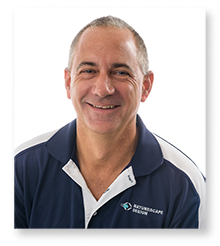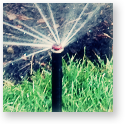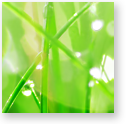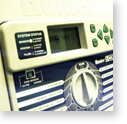Plumbing
KEEP YOUR WATER FLOWING
Effective irrigation systems require sound plumbing and adequate water access. Ensuring that is in place is a vital role of our Plumbing Department, led by Tom Layshock. Tom ensures that a new system’s water flow is sufficient and the plumbing is complete and meets code. On existing systems he is available to upgrade or repair leaking or poorly installed pipes and valves. Tom is a CCCDI certified plumber who certifies hundreds of RPZ’s annually and forwards the results directly to our customer’s municipality to confirm their compliance.
Tom also installs and maintains Rid O’ Rust systems for our customers whose well water leaves rust stains that discolor plants and sidewalks. For any of these services or if you have any plumbing questions, please reach out to Tom to get a timely and accurate solution.
Check out our expert's advice on Backflow Prevention with this must read Q & A, "The ABC's of RPZ's."
Rid O' Rust
Keeping Your Property Rust Free
Rust stains are commonly left behind when untreated well water feeds sprinklers or other types of irrigation systems. These deep brown or rust-colored hues are caused by the iron content in the water. Although they are not harmful, they can look unsightly on sidewalks, fences, driveways and any other areas that may come in contact with the well water. A good solution to prevent this from occurring is to install an injection system that uses Rid O’ Rust.
The 3 key components for a Rid O’ Rust system are:
- A ‘Stenner’ 45 MHP adjustable solution pump. This is a peristaltic metering pump with a maximum operating pressure of 100 psi. They are self-priming (a centrifugal pump that can use an air-water mixture to reach a fully-primed pumping condition). These pumps are meant to be used indoors.
- One 65 gal. solution tank with a lid in which the Rid O’ Rust is diluted in water. The tank is about four feet tall and approximately two feet in diameter.
- One ‘Irritrol’ pump start relay.
This equipment will be placed in the basement and the Rid O’ Rust solution will be pumped, via a ¼” line, to the outside and connected into the main irrigation water line after the backflow preventer. The ‘Rid O ‘Rust’ solution encapsulates, by chelation, any iron in suspension which does not allow it to adhere to hard surfaces.
Of course, in addition to these three components, there are numerous electrical and plumbing parts that ensure the pump has power and the solutions flows as needed through the system!
This equipment will be placed in the basement and the Rid O’ Rust solution will be pumped, via a ¼” line, to the outside and connected into the main irrigation water line after the backflow preventer (RPZ). The ‘Rid O ‘Rust’ solution encapsulates, by chelation, any iron in suspension which does not allow it to adhere to hard surfaces. The amount of solution that needs to be used is dependent upon the iron content in your well. We will check your iron content, set up your system so it has the correct proportion of Rid O’ Rust in the solution and leave a laminated calculator card so the owner can easily maintain the solution levels throughout the season. The end result is a property that is free of the unsightly rust stains.
For Current Customers
Maintaining Your “Rid O’ Rust” System
To help keep your ‘Rid-O-Rust’ peristaltic pump working at its peak efficiency it is recommended that a winter maintenance regimen is scheduled annually on the pump and selected components to help extend the life of this vital equipment. We can best do this service for you during the winter season – below is an overview of the processes and procedures we utilize.
System Check:
- We will remove the old peristaltic (squeeze) hose and replace it with a new one. This hose is compressed thousands of times between rollers to squeeze out a prescribed amount of ‘Rid-O-Rust’ into the sprinkler system water to eliminate the staining process.
- Remove, inspect, clean and change the ‘duckbill rubber’ inside the injection check valve assembly. This check valve assures that the mix is flowing into the sprinkler system and not backing up by a clogged ‘duckbill rubber ‘or stuck open check valve.
- Install a sight gauge in the ¼” discharge line between the pump and the check valve so that you can visually see that the mixed solution is moving through the line when the pump is running.
- The rollers will be checked for wear and replaced if necessary.
- If necessary, the spill recovery sump will be cleaned and the tube at the bottom of the sump will be checked for free flow in case of a leak. This would assure that any leak from the pump would direct that fluid back into the solution tank.
- Inspect the “index plate”. If it has developed elongated holes it will be replaced.
- ‘Aquashield’ lubricant will be applied to the head bushing and to the main shaft. The pump will be manually started to verify proper operation.
Getting Results
Well Water Test:
Since the iron level in your well can change over time we will test the raw well water for iron (fe) content in parts per million (ppm). This test should be done annually so that the proper mix of ‘Rid-O-Rust’ Formula 2000 and water can be mixed to control (encapsulate) the existing iron so that it can’t bond together to form a visual stain. If the iron level changes (up or down), we will replace and produce a new calculator card for you that we leave nearby the pump and solution tank.
Ready to Go
Inventory and Start-Up:
Finally, we’ll inventory your existing Rid O’ Rust supply and coordinate that with the requirements on the calculator card to ensure you have an adequate supply for the upcoming season. If any additional Rid O’ Rust product is needed, we will advise the homeowner of the number of gallons and the cost and ensure that it arrives no later than with the startup of the sprinkler system. We will invoice the product along with our irrigation system start-up charges.










